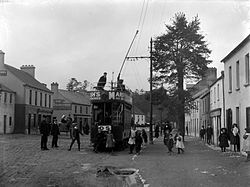Douglas, County Cork
|
Douglas Dúglas
|
|
|---|---|
| Populated place | |

Douglas at the turn of the 20th century, with a Cork Electric Tramways and Lighting Company tram
|
|
| Location in Ireland | |
| Coordinates: 51°52′35″N 8°26′9″W / 51.87639°N 8.43583°W | |
| Country | Ireland |
| Province | Munster |
| County | County Cork |
| Population (2011) | |
| • Total | 25,655 |
| Time zone | WET (UTC+0) |
| • Summer (DST) | IST (WEST) (UTC-1) |
Douglas (Irish: Dúglas or Dúbhglas, meaning "dark stream") is a suburb of Cork city, Ireland and the name given to the Roman Catholic, Church of Ireland and Civil parish in which it is contained. As its borders are ill-defined and it straddles the boundary between Cork city and County Cork, it is difficult to ascertain the exact population. The CSO gives a figure of 19,787 for the parts of Douglas that lie within Cork County. No figure is provided for the parts within Cork City, although the combined population of the Tramore A, Tramore B, Tramore C and Browningstown electoral divisions, which lie in Douglas, is 5,868. This suggests a total population of 25,655.
Douglas was first mentioned in documents in 1251. By the mid-seventeenth century, it had a population of 308 people (of whom 33 were English) and consisted of a number of large farms. The area began to develop as an urban settlement in the early eighteenth century with the opening of Donnybrook Mills in 1726. The mills produced sail-cloth and supplied sails to the Royal Navy amongst other clients. Huguenot weavers and textile workers, such as the Bernard and Pollock brothers from Belfast, came to work in the area, along with skilled workers from Ulster and Scotland. Further textile mills opened in the nineteenth century, including Lane’s Corn and Hemp Mills (1845), O’Brien’s Brothers (St Patrick’s Woollen Mills, 1882) and Conroy’s Rope and Twine Mills (1892). Most of the mills ceased to operate in the early twentieth century, although St. Patrick's Woollen Mills and Donnybrook Mills continued to operate until the 1970s.
Some of the houses built for the mill workers are still in existence, including a terrace of houses near the junction of the Grange Road and Donnybrook Hill.
...
Wikipedia

